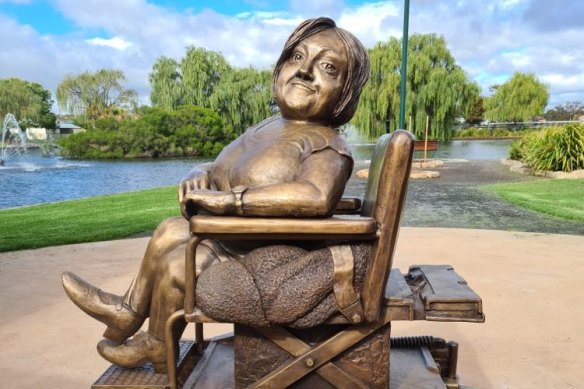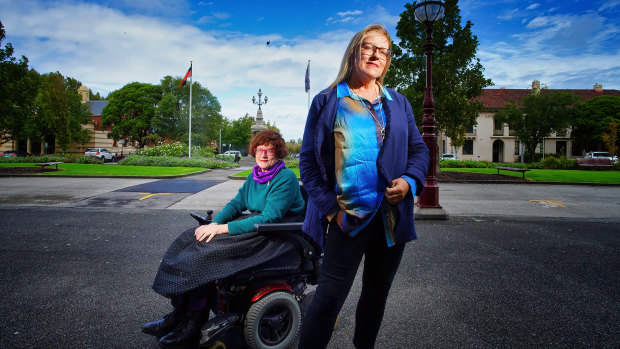‘I am not a snowflake’: Disability activist Stella Young memorialised in bronze

Two months before she died, Stella Young – comedian, writer, disability activist and self-described “crip” – wrote on Facebook how she wanted to be remembered.
“I am not a snowflake. I am not a sweet, infantilising symbol of fragility and life,” she said. “I am a strong, fierce, flawed adult woman. I plan to remain that way, in life and in death.”
The bronze statue of Stella Young by sculptor Danny Fraser.
On Thursday, a bronze statue of Young in her wheelchair by sculptor Danny Fraser will be unveiled in the disability activist’s home town of Stawell, as part of the Remembering Stella Young project.
The project aims to continue her legacy of challenging society’s perceptions of disability and striving for “a world where disability is not the exception, but the norm”.
Young’s parents, Lynne and Greg Young, were closely involved in the design of the monument, which is located in Cato Park.
“She’s right in front of the accessible playground so she’ll be letting the kids know that disability is OK,” says Lynne, a former hairdresser who provided Fraser with meticulous instructions on how Young would style her hair.
“It’s pretty humbling for us as a family to have a statue in her honour. Stella taught us so much about the disabled world, our family was so much better with her in our lives. We’re very proud that she achieved so much. She was funny and smart and just getting started, but to us she was just plain Stell.”
Young, who died in 2014 aged 32, called for the achievements of disabled people to be valued, but insisted her disability – osteogenesis imperfecta or, as she described it, “this dicky bone thing” – did not automatically make her exceptional.
“We’ve been sold the lie that disability is a Bad Thing … and to live with a disability makes you exceptional. It’s not a bad thing, and it doesn’t make you exceptional,” she said in a 2014 TEDxSydney talk.
The TED talk, which has more than four million views, took aim at society’s habit of turning disabled people into “inspiration porn”.
“I want to live in a world where we don’t have such low expectations of disabled people that we are congratulated for getting out of bed and remembering our own names in the morning.”
Young was a comedian, journalist and disability rights activist.Credit:Chris Hopkins
Young left Stawell when she was a teenager to study journalism and education at Deakin University.
She hosted Australia’s first disability culture program No Limits on Channel 31, edited the ABC’s former disability news website Ramp Up and was instrumental in advocating for the National Disability Insurance Scheme.
Young started calling herself a crip when she was 17, a label that horrified some people, but made her feel “strong and powerful”.
The description of her Tales from the Crip show at the Melbourne International Festival in 2014 read: “Stella Young is a cripple. Some people call her ‘special needs’ but she learned from a young age that ‘special’ is a code word for ‘crap’.”
Young campaigned for more accessible venues and would often tweet photos of herself stranded outside buildings.
She subscribed to the social model of disability, which says that it is inaccessible environments and hostile attitudes that disable people rather than their impairment.
“No amount of smiling at a flight of stairs has ever made it turn into a ramp,” she said in her TED talk, skewering platitudes such as “the only disability in life is a bad attitude,” as “bullshit”.
Janice Florence, a former colleague of Young’s who works for the state’s peak body for arts and disability, Arts Access Australia, was approached by Northern Grampians Shire Council to assist with making the statue accessible.
Janice Florence and Sarah Barton, who are part of the Remembering Stella Young project. Credit:Luis Enrique Ascui
“There are features such as sensor-operated voice information, the plaque is in large raised print, and the location is wheelchair accessible,” Florence says.
Filmmaker Sarah Barton, a close friend of Young’s who is making a documentary about her life and legacy, designed the website stellayoung.com.au, which can be accessed via a QR code on the plinth next to the statue.
“It links to all her writing and some videos so people can really get to know her as well as just going and visiting the statue,” she says.
The statue is the first of six artworks to be unveiled over coming months as part of the state government’s Victorian Women’s Public Art Program.
Barton suspects Young – who always said “I am not here to inspire you” – would find the idea of a statue in her honour pretty weird.
“But when you pause and you think about the symbolism of a statue, it’s actually a huge honour and it also says a great deal about the value of disabled voices.
“It says this is a person that we valued, we respected, she was part of our society, and she made an important contribution. And I think when you are set in bronze that’s basically close to being set in stone.”
The Morning Edition newsletter is our guide to the day’s most important and interesting stories, analysis and insights. Sign up here.
Most Viewed in National
From our partners
Source: Read Full Article


